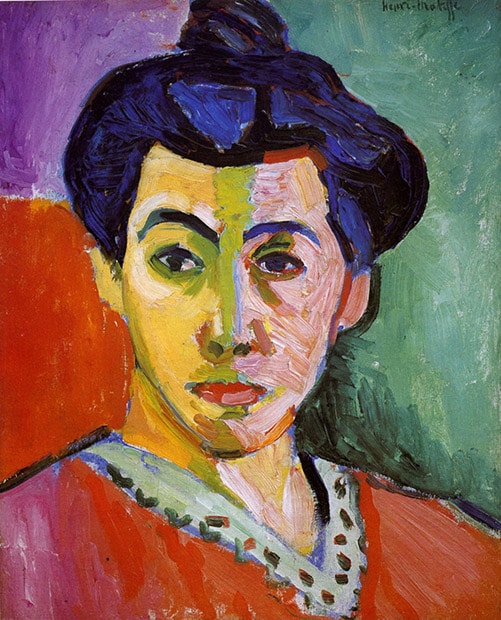The Fauvism art movement applies to a group of modernist artists in the early 20th century including Henri MatisseFrench artist Henri Matisse (1869 – 1954) is, along with Pablo Picasso, commonly regarded as pioneers in the revolutionary development of the visual arts in the 20th century. He was born to generations of weavers and raised in the northern French commune Bohain, famous for its luxury fabrics. The early exposure to textiles strongly shaped his visual language, his sense More and André Derain, who emphasized strong colour contrasts and painterly qualities with fierce brushworkMasterful brushwork is often the defining feature of great artists, where the brush becomes an extension of their arm, allowing paint to flow effortlessly onto the canvas. These artists demonstrate a profound understanding of their medium, knowing precisely when to apply thick, textured strokes or smooth, delicate ones. Their skill extends beyond mere color application; it's about the artistry of More over realistic values. Fauvism as a style started around 1904 and continued far beyond 1910. The group of Fauves however only worked together for the years between 1905 till 1908 and had three exhibitions.

Forerunners of the Fauvist movement had been Post-ImpressionismPost-Impressionism is an art movement that emerged in France in the late 19th century, following the close of the Impressionist era. While it retained the vivid color palette and real-life subject matter of Impressionism, Post-Impressionism rejected its limitations by emphasizing a more structured, formal composition and greater emotional depth. This movement was not defined by a single aesthetic but represented More, especially works by Vincent van GoghVincent van Gogh (1853 – 1890) is one of the renowned Post-Impressionist artists, best known for his striking use of colour, emphatic brushwork, and contoured forms. As a son of a pastor, the Dutch artist war brought up in a religious and cultured atmosphere. After working unsuccessfully as a clerk at a bookstore, as a salesman, and as a preacher More, the pointillism of Georges SeuratFrench artist Georges Seurat (1859 – 1891) is best known for his post-Impressionist style of Pointillism. He was born into an affluent family in Paris and educated in conventional academic painting at the École des Beaux-Arts, copying from old masters. After having attended military service, he further developed his unique style, which was influenced by the Impressionist use of colour More, Neo-Impressionism as represented by Paul Signac, and the use of saturated colour as by Paul Gauguin. On this basis, the Fauves developed a paintingPainting is a fundamental form of visual art that has been practiced for thousands of years. It involves applying pigment to a surface such as canvas, paper, or a wall. Painting can be explored through various styles, techniques, and mediums, each offering unique possibilities for expression and creativity. Historical Background • Ancient Beginnings: The history of painting dates back to More style characterized by a high degree of simplification in subject matter conveyed in strident colours.
The name Les Fauves (‘the wild beasts’) was coined by the art critic Louis Vauxcelles when seeing the work of Henri MatisseFrench artist Henri Matisse (1869 – 1954) is, along with Pablo Picasso, commonly regarded as pioneers in the revolutionary development of the visual arts in the 20th century. He was born to generations of weavers and raised in the northern French commune Bohain, famous for its luxury fabrics. The early exposure to textiles strongly shaped his visual language, his sense More and André Derain at the exhibition Salon d’Automne in Paris in 1905. The paintings the two artists exhibited were made using non-naturalistic, bold colours and loose dots of paint the depict simplified, almost abstract forms.
The Fauvists group, which also included artists such as Georges Braque, Raoul Dufy, Georges Rouault, and Maurice de Vlaminck, had a strong interest in scientific colour theories developed in the 19th century, especially those relating to complementary colours – pairs of colours that appear opposite of each other in models like the colour wheelColour Wheel Art and Design: As a key element in colour theory, the colour wheel is used traditionally for guidance for colour mixing and colour combination. The first colour wheel was designed by Sir Isaac Newton in 1666 who experimented with prism. His experiments led him to the theory of primary colours, from which all other colours were derived. Newton’s More.
Although Fauvism was one of the first avant-garde movements in the 20th century, for most members it served only as a transitional phase. After 1908 most Fauvists adopted a more neoclassical or analytical approach, embracing order and structure instead. For example, one-time Fauvist Georges Braque developed CubismSynthetic cubism was the later period of the Cubist art movement generally dated from 1912 – 1919. Artists of Synthetic Cubism moved away from the multi-perspective approach of Analytical Cubism in favour of flattened images that dispensed allusions of the three-dimensional space. Pablo Picasso, Clarinet, Bottle of Bass, Newspaper, Ace of Clubs (2013) The approach of the analytical phase was More together with Pablo PicassoPablo Picasso (1881–1973), was a Spanish painter, sculptor, graphic artist, and resident in France from 1904. He was a dominant figure in avant-garde movements in the first half of the 20th century due to his technical versatility and prolific inventiveness. picasso-self-portrait Picasso’s progression in his early work is largely categorized by predominant colour schemes: His Blue Period (1901-1904) features motifs More. Henri MatisseFrench artist Henri Matisse (1869 – 1954) is, along with Pablo Picasso, commonly regarded as pioneers in the revolutionary development of the visual arts in the 20th century. He was born to generations of weavers and raised in the northern French commune Bohain, famous for its luxury fabrics. The early exposure to textiles strongly shaped his visual language, his sense More yet continued the path of Fauvism using simplified shapes and emotive colours.
